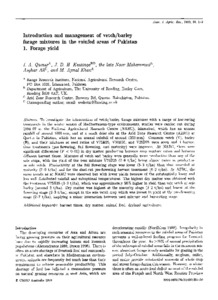| dc.contributor.author | Qamar, I.A. |
| dc.contributor.author | Keatinge, J.D.H. |
| dc.contributor.author | Mohammad, N. |
| dc.contributor.author | Ali, A. |
| dc.contributor.author | Khan, M.A. |
| dc.date.accessioned | 2019-12-04T11:23:35Z |
| dc.date.available | 2019-12-04T11:23:35Z |
| dc.date.issued | 1999 |
| dc.identifier.citation | Qamar, I.A., Keatinge, J.D.H., Mohammad, N., Ali, A. & Khan, M.A. (1999). Introduction and management of vetch/barley forage mixtures in the rainfed areas of Pakistan. 1. Forage yield. Australian Journal of Agricultural Research, 50(1), 1-10. |
| dc.identifier.issn | 0004-9409 |
| dc.identifier.uri | https://hdl.handle.net/20.500.12478/4053 |
| dc.description.abstract | To investigate the introduction of vetch/barley forage mixtures with a range of harvesting treatments in the winter season of Mediterranean-type environments, studies were carried out during 1994–97 at the National Agricultural Research Centre (NARC), Islamabad, which has an annual rainfall of around 1000 mm, and at a much drier site at the Arid Zone Research Centre (AZRC) at Quetta in Pakistan, which has an annual rainfall of around (223 mm). Common vetch (V), barley (B), and their mixtures at seed ratios of V75B25, V50B50, and V25B75 were sown and 3 harvest time treatments (pre-flowering, full flowering, and maturity) were imposed. At NARC, there were significant differences (P < 0·01) in dry matter production between crop mixture ratios and between different harvest times. Mixtures of vetch and barley were generally more productive than any of the sole crops, with the yield of the best mixture V75B25 (7·6 t/ha) being almost twice as productive as sole vetch. Productivity at the full flowering stage was lower (5·3 t/ha) than that recorded at maturity (7·0 t/ha) and for the dual-cut pre-flowering harvest treatment (6·2 t/ha). At AZRC, the same trends as at NARC were observed but with lower yields because of the substantially lower and less well distributed rainfall and suboptimal temperatures. The highest dry matter was obtained with the treatment V75B25 (3·3 t/ha), which was approximately 50% higher in yield than sole vetch or sole barley (around 2 t/ha). Dry matter was highest at the maturity stage (3·2 t/ha) and lowest at the flowering stage (2·3 t/ha), except in the sole vetch crop which was lowest in yield at the pre-flowering stage (2·7 t/ha), implying a minor interaction between seed mixture and harvesting stage. |
| dc.language.iso | en |
| dc.subject | Dry Matter |
| dc.subject | Animal Feed Crops |
| dc.subject | Forage |
| dc.subject | Barley |
| dc.subject | Agricultural Resources |
| dc.title | Introduction and management of vetch/barley forage mixtures in the rainfed areas of Pakistan 1. Forage yield |
| dc.type | Journal Article |
| dc.description.version | Peer Review |
| cg.contributor.affiliation | National Agricultural Research Centre, Pakistan |
| cg.contributor.affiliation | University of Reading |
| cg.contributor.affiliation | Arid Zone Research Centre, Pakistan |
| cg.contributor.affiliation | International Institute of Tropical Agriculture |
| cg.coverage.region | Asia |
| cg.coverage.region | South Asia |
| cg.coverage.country | Pakistan |
| cg.coverage.country | Australia |
| cg.isijournal | ISI Journal |
| cg.authorship.types | CGIAR and developing country institute |
| cg.iitasubject | Climate Change |
| cg.iitasubject | Farm Management |
| cg.accessibilitystatus | Limited Access |
| local.dspaceid | 99339 |

